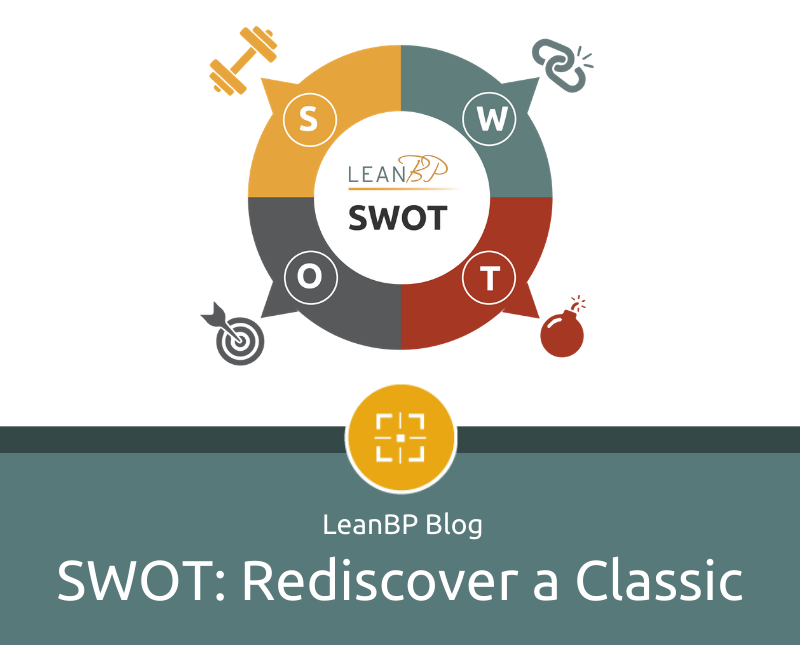 Ever go through your closet or toolbox and find something useful you forgot you had—and wound up being glad you did?
Ever go through your closet or toolbox and find something useful you forgot you had—and wound up being glad you did?
I suggest you rummage back through your business toolbox and pull out your SWOT analysis template. In my experience, most people have learned or at least heard about SWOT in school, but very few people use it. Like blocking and tackling, it’s necessary but underrated.
SWOT (Strengths, Weaknesses, Opportunities, and Threats) is a visual exercise, done in the form of a quad chart. Visual management increases situational awareness, synergy, and sense of urgency for both individuals and organizations—helping you make better decisions, sooner. Used with other elements of the blue line from the LeanBP Strategic Alignment & Deployment Guide, SWOT helps complete the picture by outlining the intangibles.

Start by determining your scope. If you’re a supervisor, you need to perform this analysis for your area of responsibility, and also possibly for the distinct roles you perform. For example, you might look at your department holistically, and then do the exercise again as an audit of your leadership skills. If you’re not a supervisor, but an individual contributor, you would look at SWOT through the lens of doing your job. This exercise is about seeing your situation fully—resist the temptation to problem-solve at this stage!
The example below shows common internal and external items to consider, but please don’t limit yourself to these—you and your organization are unique.

Strengths and Weaknesses
Objectively brainstorm the strengths internal to you or internal to your department depending on the scope you’ve identified; these are things that help you achieve your articulated mission. Then identify the internal weaknesses that hinder your mission. Note that some strengths can also be weaknesses in a certain context. I once worked with a company with a strong and successful culture, which was a strength, but that culture made change difficult, so we also listed it as a weakness.
A complete list of strengths and weaknesses gives you a clear picture of what you’re working with—in other words, the current state.
Opportunities and Threats
The bottom half of the quad chart is about the future state—external opportunities and threats.
Opportunities are entities or events that can help you achieve your mission, but that you are aren’t currently leveraging to their potential. The examples shown above can be helpful, but remember to be creative. For example, once my department was struggling with poor quality, which we traced to poor soldering (an internal weakness). Once we had identified the weakness, we saw the opportunity: to reach out to a local technical college to provide soldering training for all our technicians.
Threats are external entities or events that can hinder your mission. Sometimes, thinking through this part of the exercise can be overwhelming—the current world situation is one of those times. Consider competition, changing technology, and reorganizations. (And pandemics, unfortunately.) You won’t be able to prepare for things if you haven’t visualized them.
As with strengths and weaknesses, opportunities and threats can be two sides of the same coin. The pandemic has been horrific for all in terms of sickness and death. In terms of business, what was detrimental to some (restaurants) has been a boost for others (grocery chains).
How Prepared Are You?
I’ve always been fascinated by a Harvard Business Case study about a 1984 Shell Oil learning session in which they theorized what might happen if the price of oil went as low as $15 a barrel. It seemed ridiculous at the time because the price was $28 and rising. Just 16 months later, the price plunged to $10 a barrel—and their exercise in identifying threats helped them get through the panic. (“Planning as Learning.” De Geus, Arie P., Harvard Business Review, March–April 1988.)
Organizations that visualize hypothetical emergencies are much better at dealing with real ones.
Similarly, when I did my own SWOT analysis a few years ago, I realized that a bigger emergency fund would be necessary to head off some of the threats I identified to my business, such as government shutdowns. And though I didn’t anticipate the pandemic, that cash cushion has been a lifesaver.
On the other hand, the airline industry—which I know very well—has time after time failed to anticipate what’s coming throughout its history of bullwhip expansion and draconian contraction. It makes me cringe.
So many organizations ignore this simple strategizing activity. Leadership hasn’t even done it at the top, let alone encouraged it down the chain of command to different locations and levels. And those who have done it often haven’t communicated it or shared it for feedback. The more people you can involve, the more angles you’ll see that you couldn’t otherwise. The more often you do it—I recommend quarterly, or more often during turbulent times—the more agile you’ll be in responding to change.
I have every single one of my students and clients perform this exercise, and I have facilitated it for many military, government, and corporate leaders. All agree that it’ s harder than it looks at first glance, but it forces you to think, and it starts a valuable process that never ends (though future iterations are easier than the first). I use it myself to search for things not easily seen and to put problems on paper and into perspective. It’s a great anxiety-reducer.
Isn’t it our obligation to our employees, organizations, and stockholders—and to ourselves and our families—to be looking internally for our weaknesses and scouting the horizon for threats so we aren’t blindsided? And wouldn’t it be comforting to create a plan by using our strengths and opportunities to mitigate those weaknesses and threats?
That’s the simple but powerful magic of SWOT. So put this old shirt on—it’s definitely back in fashion!
